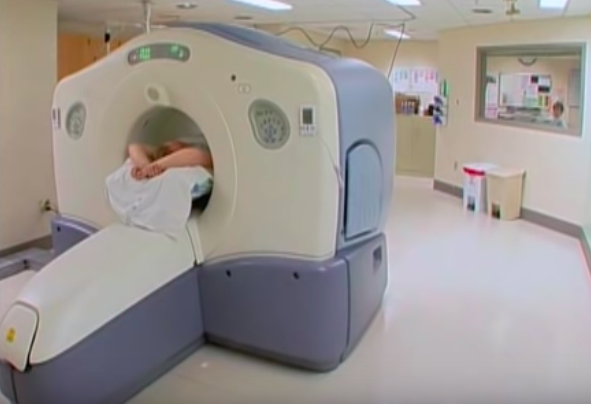
Combined with a CT or MRI scan, a PET scan can produce multidimensional, color images of the inside workings of the human body. It shows not only what an organ looks like, but how it is functioning.
A PET scan is used to diagnose certain health conditions, to plan treatment, to find out how an existing condition is developing, and to see how effective a treatment is.
Facts on PET scans
Some key points about PET scans.
- Often used to diagnose a condition or to track how it is developing.
- Used alongside a CT or MRI scan, shows how a part of the body is working.
- PET scans are often used to investigate epilepsy, Alzheimer’s disease, cancer, and heart disease.
How Scans Work
In a PET scan, a machine detects radiation that is emitted by a radiotracer. The radiotracer consists of radioactive material Trusted Source that is tagged to a natural chemical, such as glucose. This radiotracer is injected into the body, where it travels to cells that use glucose for energy.
The more energy a group of cells needs, the more the radiotracer will build up in that location. This will show up on images that are reconstructed by a computer. These cells, or activity, show up as hot or cold spots.
Active areas that are bright on a PET scan are known as the “hot spots.” Where cells need less energy, the areas will be less bright, and are called “cold spots.”
Compared with normal cells, cancer cells are very active in using glucose, so a radiotracer made with glucose will light up areas of cancer. A radiologist examines the image produced on the computer and will report the findings to a doctor.
Uses For Scans
PET scans are often used with CT or MRI scans to help make a diagnosis or to get more data about a health condition and the progress of any treatment. While an MRI or CT scan shows how part of the body looks, a PET scan can reveal Trusted Source how it is functioning.
PET scans are commonly used to investigate a number of conditions.
- Epilepsy: It can reveal which part of the brain the epilepsy is affecting. This can help doctors decide on the most suitable treatment, and it can be useful if surgery is necessary.
- Alzheimer’s disease: PET scans can help diagnose Trusted Source Alzheimer’s disease by measuring the uptake of sugar in specific parts of the brain. Brain cells that are affected by Alzheimer’s tend to use glucose more slowly than normal cells.
- Cancer: PET scans can reveal the presence and stage of cancer, show whether and where it has spread, and help doctors decide on treatment. A PET scan can give an idea of how well chemotherapy is working, and it can detect a recurring tumor sooner than other techniques.
- Heart disease: A PET scan can help detect which parts of the heart have been damaged or scarred, and it can help identify circulation problems in the working of the heart. This information can help plan treatment options for heart disease.
- Medical research: Researchers can learn vital information by using PET scans, especially about the workings of the brain.
The Procedure
A PET scan is normally an outpatient procedure. The patient should not consume any food for at least 4 to 6 hours before the scan, but should drink plenty of water. Avoid caffeine for at least 24 hours before the scan.
During the procedure, the doctor will inject a small amount of radiotracer into a vein. The tracer can also be breathed in as a gas, taken by mouth, or injected directly into an organ. Depending on which the organ is involved, it may take from 30 to 90 minutes for the radiotracer to reach the targeted part of the body being checked on.
The patient will be asked to stay still and not talk. Some patients are given medication to relax. When the patient is ready, they are taken to a special room for the scan. They will lie down on a cushioned examination table. The table slides into a large hole so that the patient is surrounded by the machine.
The patient will have to stay as still as possible. During the scan, the machine takes images. Depending on which part of the body is being scanned, this takes about 30 minutes.
A qualified practitioner will watch the patient during the scan. The entire testing procedure typically takes about 2 hours. Most patients can go home as soon as the scan is finished.
Patients should consume plenty of liquid to flush the radioactive drugs out of their system more quickly. The radiotracers should have left the body completely within 3 to 4 hours.
What are the Risks
There is a risk of radiation exposure. For most people, the benefits of having a PET scan clearly outweigh the risks. However, because a PET involves radioactive material, it is not suitable for everyone. A pregnant woman should not have a PET scan, as the radioactive material may affect the fetus or the infant.
If a woman is breastfeeding, she should follow directions for pumping and discarding breast milk, and ask the doctor when it is safe to resuming breastfeeding based on the test performed.
Following a PET scan, a patient may be advised to stay away from pregnant women, infants, and young children for a few hours, as the radioactivity poses a small risk.
Hollywood Diagnosticss Center has been recognized as a leader in the medical Diagnosticss field while performing over 30,000 Diagnostics procedures annually. The center continues to be at the forefront of medical technology by progressively updating its equipment and procedures to reflect the latest advances in medicine. HDC is your complete, one source provider of all Diagnostics services.
If you require for any reasons an MRI, a PET Scan, a mammogram, ultrasounds of any kind, an EKG or even a bone density scan, this is the center that can take care of all of those tests and needs and more. You can even Request ann appointment by clicking RIGHT HERE!
